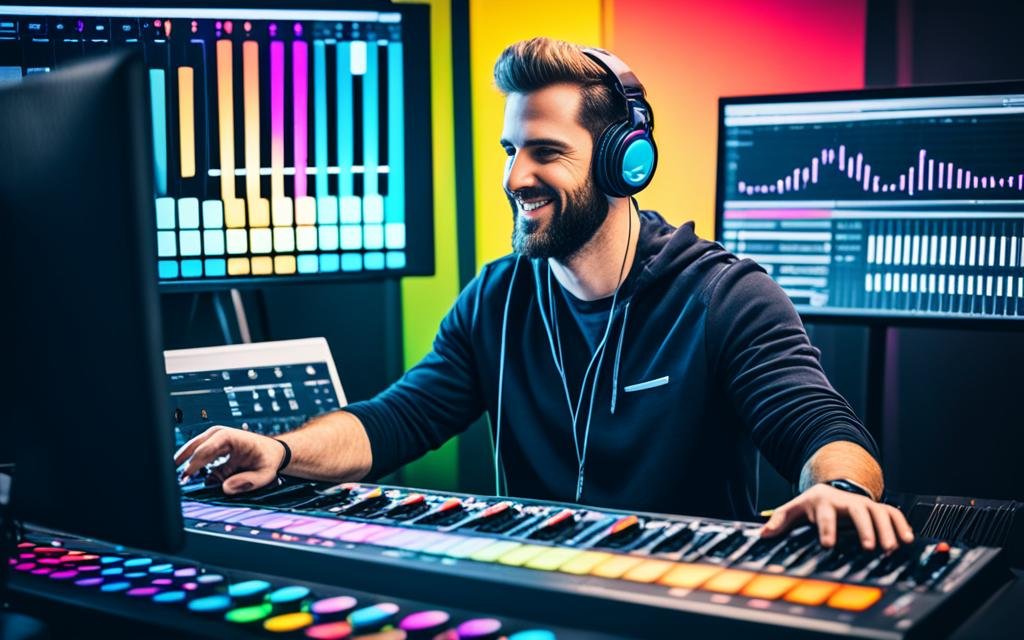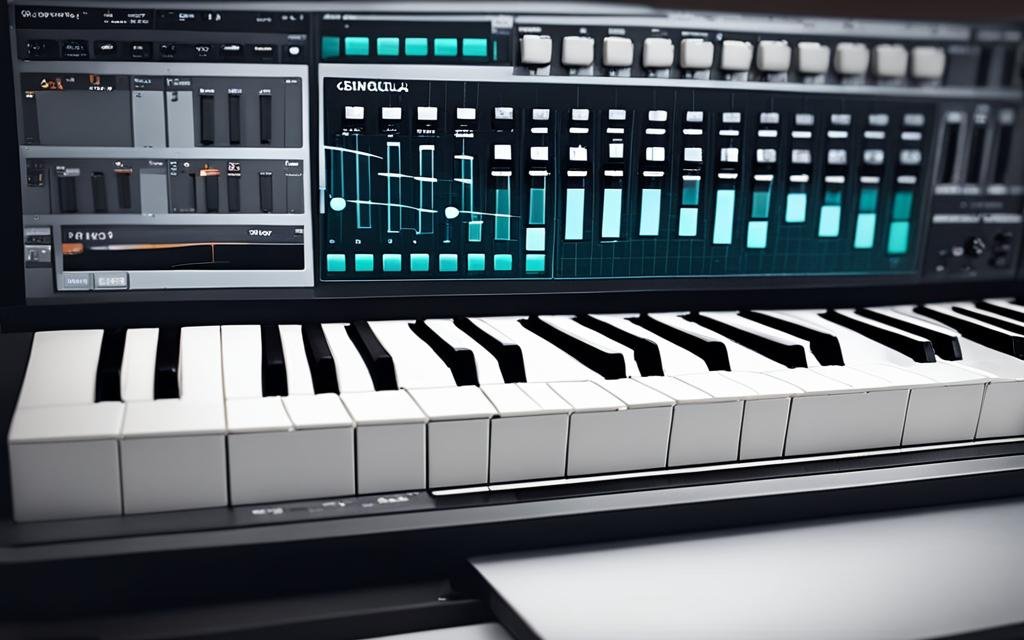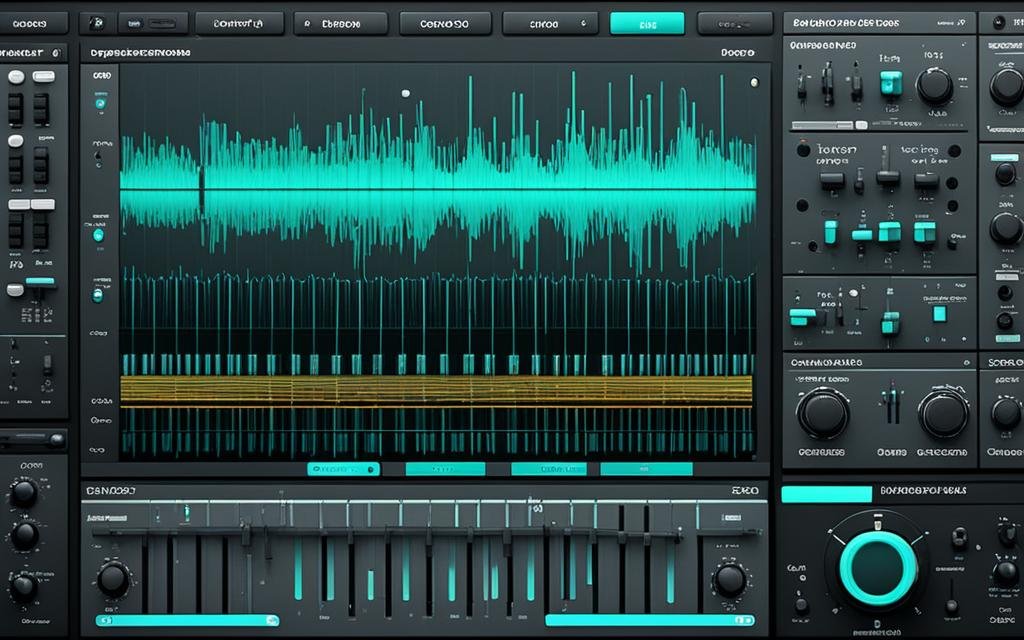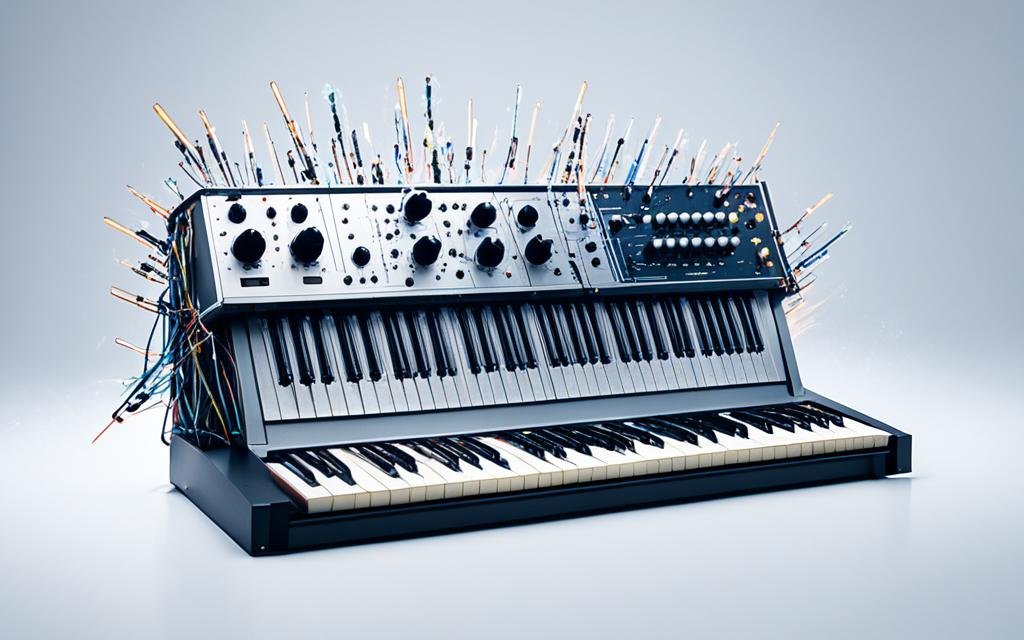Greetings! Are you ready to take your music production skills to the next level? In this article, I will share valuable tips, techniques, and tricks that will elevate your music production game and help you create professional-quality tracks.
Whether you’re a beginner starting out on your music production journey or a seasoned producer looking to refine your skills, these tips will guide you towards achieving mastery in the art of music production.
From music mixing tips to mastering secrets, from software recommendations to gear advice, this article covers a wide range of topics to enhance your music production workflow. So let’s dive in and unlock the secrets of creating music that resonates with your audience and showcases your unique style and talent.
Key Takeaways:
- Explore different techniques and tricks to improve your music production skills
- Invest in quality music production software and gear for optimal results
- Master the art of music mixing and learn the key principles of mastering music
- Follow best practices and develop a streamlined music production workflow
- Seek advice from music production tutorials and experts to accelerate your learning process
Embracing the Beginner’s Journey in Music Production
In the world of music production, every journey begins with a single step. For those venturing into the realm of sound creation, it’s important to embrace the exciting path of the beginner. This section will explore the fundamental principles and practical tips that can help you navigate the early stages of your music production journey.
Starting with Practice Projects
When starting out, it’s essential to dive headfirst into the process of creating music. A great way to do this is by working on practice projects. These projects allow you to experiment with different genres, styles, and techniques while honing your skills. By immersing yourself in practice projects, you’ll gain hands-on experience and build a strong foundation for future endeavors.
Inspiration can come from anywhere, so don’t be afraid to draw from your own musical tastes and preferences. Use these practice projects as an opportunity to explore different genres, experiment with various instruments and sounds, and push your creative boundaries. Remember, the goal is to learn and grow, so don’t be too hard on yourself if the end result isn’t perfect.
Progressing through Technique Exploration
As you gain confidence and proficiency in music production, it’s crucial to continue expanding your knowledge and skill set. One way to do this is through technique exploration. Dive deeper into specific production techniques such as sound design, mixing, and arrangement. Learn from industry professionals, watch tutorial videos, and experiment with different software and hardware tools to discover new methods and approaches.
Approach technique exploration with an open mind and a willingness to step outside of your comfort zone. Be curious and experimental, embracing the joy of discovering new sounds and ways to manipulate them. Through this exploration, you’ll develop your own unique style and voice as a music producer.
Balancing Perfection and Growth
As you progress in your music production journey, it’s important to strike a balance between striving for perfection and allowing room for growth. Perfectionism can be a creative roadblock, causing you to get stuck in a never-ending loop of fine-tuning and self-criticism. Remember that music production is an iterative process, and growth comes from embracing imperfections and learning from them.
Allow yourself the freedom to experiment, make mistakes, and learn from them. Embrace the learning opportunities that come with each project, and don’t be afraid to take risks and try new things. Music production is a journey of continuous learning and growth, and by embracing the process, you’ll unlock new levels of creativity and mastery.
| Benefits of Embracing the Beginner’s Journey | Practical Tips for Beginners |
|---|---|
|
|
Building Blocks of Your First Tracks
In this section, we will explore the essential building blocks of creating your first tracks in music production. Whether you’re a beginner or looking to refine your skills, understanding these fundamental elements and techniques will help you lay a solid foundation for your music production journey.
One of the key aspects of music production is beat creation. The rhythm and groove of your tracks can greatly influence their overall impact. Experiment with different drum patterns, explore various samples and sounds, and learn how to create dynamic drum patterns that drive your music forward.
Another crucial element is melody composition. Develop your skills in crafting catchy and memorable melodies that resonate with your audience. Experiment with different scales, chord progressions, and harmonies to create emotional and captivating musical motifs.
Once you have your beats and melodies, it’s important to learn how to arrange them effectively. Understand the principles of arrangement, such as verse-chorus structure, bridges, and breakdowns, to create a cohesive and engaging musical journey for your listeners. Experiment with dynamics, tension, and release to keep your audience captivated throughout the track.
Remember, practice is key to mastering these building blocks. Don’t be afraid to experiment, try new techniques, and learn from your mistakes. Continued learning and exploration of music production techniques will help you refine your skills and create music that resonates with your audience.
Effective Loop Manipulation and Arrangement
In music production, loop manipulation and arrangement are essential techniques for creating unique and engaging sounds. By understanding loop dynamics and exploring creative transformations of basic loops, you can elevate your music productions to a new level.
Understanding Loop Dynamics
Loop dynamics refer to the changes and variations in a loop over time. By manipulating loop dynamics, you can add movement, interest, and complexity to your music. Here are some techniques to consider:
- Layering: Combine multiple loops with different rhythms, melodies, or textures to create a fuller and more dynamic sound.
- Automation: Use automation to modulate parameters such as volume, panning, and effects over time, adding variation and creating an evolving sound.
- Slicing: Chop up a loop into smaller segments and rearrange them to create new rhythms and patterns.
Experiment with these techniques and explore how different loop manipulations can transform the energy and feel of your music.
Creative Transformations of Basic Loops
One of the keys to creating unique and innovative music is to think outside the box when working with loops. Don’t be afraid to experiment and push the boundaries of what a loop can do. Here are some ideas to get you started:
- Reverse: Reverse a loop to create a reverse effect, adding tension and suspense to your music.
- Time-Stretching: Stretch or compress a loop to change its duration and create interesting rhythmic or melodic variations.
- Mangling: Apply various effects, such as distortion, filtering, or modulation, to completely transform the sound of a loop.
Remember, the goal is to create unique and distinctive sounds that stand out from the crowd. Don’t be afraid to experiment, take risks, and let your creativity soar.

The Significance of MIDI in Music Production
MIDI, or Musical Instrument Digital Interface, plays a crucial role in modern music production. It provides a powerful framework for creating and manipulating musical elements, enhancing your creativity and improving your workflow. In this section, we will explore the significance of MIDI in music production, as well as share valuable tips and techniques for effective use.
MIDI allows you to control various parameters of your music software, such as virtual instruments, synthesizers, and drum machines. It functions as a digital language that allows different devices and software to communicate and synchronize with each other. By using MIDI, you can easily compose melodies, program drum patterns, and control the dynamics and expression of your music.
MIDI is like the conductor of your digital orchestra, giving you the power to shape and mold your musical ideas with precision and flexibility.
One of the key advantages of MIDI is its non-destructive nature. Unlike audio recordings, MIDI data can be easily edited and manipulated without losing quality. This means that you can change the timing, pitch, and even the instrument sounds after recording, providing endless possibilities for experimentation and creativity.
Whether you’re a beginner or an experienced producer, mastering MIDI techniques is essential for taking your productions to the next level. Here are some tips for effective use of MIDI in music production:
- Create expressive melodies and chord progressions using MIDI keyboards or controllers.
- Use MIDI quantization to tighten up your performances and ensure precision in your rhythms.
- Experiment with MIDI effects such as arpeggiators, chord generators, and step sequencers to add complexity and interest to your tracks.
- Utilize MIDI automation to add dynamic changes to parameters like volume, panning, and effects over time.
- Explore the vast library of MIDI packs and MIDI plugins available to enhance your production workflow and inspire new ideas.
By understanding and harnessing the power of MIDI, you can unlock a world of possibilities in your music production. From creating complex arrangements to exploring unique sound design, MIDI is an invaluable tool that can elevate your productions to new heights.
Music Production Tips: Polishing Arrangements
In music production, the arrangement of a song plays a crucial role in creating impact and engaging the audience. Effective arrangement techniques can elevate your music to new heights, making it stand out from the crowd. In this section, we will explore tips for polishing arrangements and discuss how to structure songs for maximum impact.
Structuring Songs for Impact
When structuring a song, it’s important to consider the overall flow and progression. A well-structured song captivates the listener and keeps them engaged from start to finish. Here are some tips for structuring songs:
- Start with a strong hook or catchy introduction to grab the listener’s attention.
- Build up the energy and intensity throughout the song, gradually introducing new elements and layers.
- Create contrast by incorporating verses, choruses, bridges, and instrumental breaks. This adds variety and keeps the song interesting.
- Pay attention to the dynamics within the sections of the song. Use dynamics to create tension and release, adding depth and emotion to the arrangement.
- Consider the arrangement of instruments and vocals. Experiment with different combinations and textures to create a unique sonic landscape.
By structuring songs strategically, you can create a journey for the listener, taking them on an emotional and musical ride.
Automations and Dynamics in Song-Building
To take your arrangements to the next level, it’s essential to utilize automation and dynamics. These techniques can bring life and movement to your songs. Here are some ways to incorporate automations and dynamics:
- Use volume automation to create swells, fades, and other dynamic changes. This adds expression and shape to the different sections of your song.
- Experiment with panning automation to create movement and spatial effects. This can make your arrangements feel more immersive and three-dimensional.
- Explore the use of effects automation, such as filter sweeps, delays, and reverbs. This adds interest and variation to specific sections of your song.
- Consider tempo and time signature changes to add unpredictability and excitement to your arrangements.
By leveraging automations and dynamics, you can create dynamic and captivating arrangements that enhance the overall impact of your music production.
Now that we’ve explored techniques for polishing arrangements, let’s dive into the significance of using reference tracks as a guiding tool for enhancement in music production.

Reference Tracks: A Guiding Tool for Enhancement
In the world of music production, the importance of reference tracks cannot be overstated. Whether you are a beginner or a seasoned producer, analyzing and studying reference tracks can greatly enhance your skills and elevate your productions to new heights.
So, what exactly are reference tracks? They are professionally produced songs or tracks that serve as a benchmark for the sound quality, mixing, arrangement, and overall production value that you aspire to achieve in your own music.
Why are reference tracks so valuable? Well, they provide a point of reference to compare your own mixes and productions. By carefully studying and listening to reference tracks, you can gain insights into how top-tier producers have achieved certain sonic characteristics, such as punchy drums, clear vocals, balanced frequencies, and powerful dynamics.
One effective way to use reference tracks is by analyzing the frequency balance. By comparing the frequency spectra of your own tracks to that of a well-mixed reference track, you can identify any imbalances or areas that may need improvement. This can help you make informed decisions during the mixing process, ensuring that your tracks sound polished and professional.
Another way to utilize reference tracks is by examining the arrangement and structure. Pay attention to how the reference track transitions between sections, builds tension, and maintains the listener’s interest. Take note of the arrangement techniques used, such as the introduction of new elements, the use of breakdowns or bridges, and the overall flow of the song.
Additionally, reference tracks can provide inspiration and spark creativity. They can serve as a starting point when you’re feeling stuck or unsure about where to take your own track. By referencing the arrangement, sound design, and overall vibe of a reference track, you can jumpstart your creative process and explore new ideas that align with your artistic vision.
Remember, reference tracks are not meant to be copied or imitated exactly. The goal is to learn from them, extract techniques and ideas, and adapt them to your own unique sound and style. By studying a variety of reference tracks across different genres and eras, you can broaden your musical palette and develop a deeper understanding of music production as a whole.
In conclusion, reference tracks are an invaluable tool that can significantly enhance your music production skills. By analyzing and studying them, you can improve your mixing, arrangement, and overall production techniques. So, don’t hesitate to incorporate reference tracks into your music production workflow and let them guide you on your journey towards mastery.
Crafting and Refining MIDI Sounds
In the world of music production, MIDI (Musical Instrument Digital Interface) plays a crucial role in creating unique and expressive sounds. With the right techniques, you can take your MIDI sounds to the next level and elevate your music production to new heights. In this section, we will explore the art of crafting and refining MIDI sounds, covering sound design, modulation, and manipulation techniques that will add depth and creativity to your compositions.
One of the key elements in crafting MIDI sounds is sound design. By tweaking the parameters of virtual instruments and synthesizers, you can shape and mold the sound to fit your vision. Experiment with oscillators, filters, envelopes, and effects to create custom timbres that stand out in your music production.
Modulation is another powerful tool that can bring life and movement to your MIDI sounds. Utilize techniques such as LFO (Low-Frequency Oscillation), modulation envelopes, and velocity sensitivity to automate parameters and add dynamic variations. This can result in evolving textures, expressive melodies, and rhythmic patterns that captivate the listener’s attention.
Manipulating MIDI notes and patterns is yet another way to refine your MIDI sounds. Experiment with quantization, swing, and groove settings to add subtle nuances and humanize the performance. Additionally, explore techniques like arpeggiators and step sequencers to generate complex melodic sequences and rhythmic patterns that are both captivating and unique.

Remember, the key to crafting and refining MIDI sounds is experimentation and exploration. Don’t be afraid to step outside of your comfort zone and try new techniques. With practice and patience, you’ll develop your own signature sound and take your music production skills to new heights.
Advanced Mixing Techniques for Distinctive Audio Quality
In the world of music production, achieving a distinctive audio quality is paramount. To help you take your mixes to the next level, this section will explore advanced mixing techniques that can elevate the overall sound of your tracks. We will focus on two key aspects: mastering midrange for clarity and implementing compression strategies for balanced dynamics.
Mastering Midrange for Clarity
The midrange frequencies play a crucial role in defining the clarity and presence of your mix. By mastering the midrange, you can ensure that each element in your mix can be heard clearly without overpowering others.
Here are some EQ techniques and strategies to help you achieve clarity in the midrange:
- Frequency carving: Identify the key elements in the midrange that you want to highlight and use EQ to boost their presence. Likewise, identify any frequencies that may be causing muddiness or masking other elements, and use EQ to reduce their prominence.
- Surgical EQ: Use precise EQ cuts or boosts to sculpt and shape individual instruments or elements in the midrange. This technique can help you create separation and balance in your mix.
- Stereo width: Experiment with panning and stereo imaging techniques to create space and width in the midrange. This can enhance the clarity and definition of each element.
Remember, mastering midrange for clarity requires a delicate balance. It’s essential to constantly listen and make critical decisions based on the overall mix.
Compression Strategies for Balanced Dynamics
Compression is a powerful tool that allows you to control the dynamics of your mix, ensuring balance and cohesion. When used effectively, compression can add energy, tighten up performances, and make your mix sound more polished.
Here are some compression techniques to consider for achieving balanced dynamics:
- Input gain control: Adjust the input gain to control the threshold at which the compression starts to work. This can help you tame excessive peaks or bring out the quieter elements in your mix.
- Ratio and attack settings: Experiment with different compression ratios and attack settings to shape the envelope and sustain of individual elements. For example, a faster attack can add punch to drums, while a slower attack can smooth out vocal performances.
- Parallel compression: Blend a heavily compressed signal with the dry signal to add depth and impact to individual tracks or the entire mix. This technique can help you achieve a more controlled and cohesive sound.
Compression is a nuanced process, and it’s important to apply it judiciously. Always listen critically and make adjustments based on the specific needs of your mix.
By mastering midrange for clarity and implementing compression strategies for balanced dynamics, you can enhance the audio quality and overall impact of your mixes. These advanced mixing techniques will help you create professional-sounding tracks that stand out.
| Mixing Technique | Description |
|---|---|
| Mastering Midrange for Clarity | Using EQ techniques and strategies to achieve clarity in the midrange frequencies, enhancing the presence and separation of elements. |
| Compression Strategies for Balanced Dynamics | Utilizing compression techniques to control the dynamics of the mix, adding energy and polish while maintaining balance and cohesion. |

Conclusion
Throughout this article, I have shared a wealth of tips and techniques to help you elevate your music production skills and embark on a journey towards mastery. By embracing the beginner’s journey, starting with practice projects, and progressing through technique exploration, you can lay a solid foundation for your music production career.
Remember to balance the pursuit of perfection with the need for growth. Allow yourself room to experiment and make mistakes, as it is through these experiences that we truly learn and evolve as music producers.
As you continue on your music production journey, I encourage you to set a goal of completing 100 projects. This milestone will not only give you ample opportunities to apply the tips and techniques you have learned but also provide a sense of accomplishment and growth. After reaching this milestone, consider taking the next step by exploring advanced music production techniques, collaborating with other musicians, or seeking mentorship and guidance from industry professionals.
Be sure to continue your learning by exploring music production tutorials, online resources, and attending workshops or courses. The more you invest in your craft, the closer you will get to achieving music production mastery. Remember, there is always room to grow and improve, so embrace the process and enjoy the wonderful world of music production.
FAQ
What are some beginner music production tips?
What are the essential elements in creating your first tracks?
How can I manipulate and arrange loops in my music production?
How can MIDI enhance my music production?
What are some tips for polishing arrangements in music production?
How can I use reference tracks to enhance my music production?
How can I craft and refine MIDI sounds in music production?
What are some advanced mixing techniques for achieving distinctive audio quality?
Source Links
- https://audioservices.studio/blog/the-road-map-to-learn-music-production
- https://musicproductionglossary.com/living-for-the-music/
- https://mixingmonster.com/midrange-mixing/
